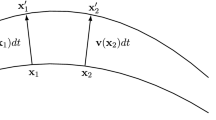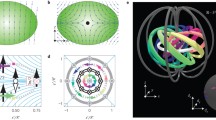Abstract
The problem of existence of knot-like solitons as the energy-minimizing configurations in the Faddeev model, topologically characterized by an Hopf invariant, Q, is considered. It is proved that, in the full space situation, there exists an infinite set S of integers so that for any m ∈ S, the Faddeev energy, E, has a minimizer among the class Q = m; in the bounded domain situation, the same existence theorem holds when S is the set of all integers. One of the important technical results is that E and Q satisfy the sublinear inequality E ≤ C|Q|3/4, where C > 0 is a universal constant, which explains why knotted (clustered soliton) configurations are preferred over widely separated unknotted (multisoliton) configurations when |Q| is sufficiently large.
Similar content being viewed by others
References
Atiyah, M., The Geometry and Physics of Knots, Cambridge: Cambridge Univ. Press, 1990.
Kauffman, L. H., Knots and Physics, River Ridge, New Jersey: World Scientific, 2000.
Finkelstein, D., Rubinstein, J., Connection between spin, statistics, and kinks, J. Math. Phys., 1968, 9: 1762–1779.
Jehle, H., Flux quantization and particle physics, Phys. Rev. D, 1972, 6: 441–457.
Kibble, T. W. B., Some implications of a cosmological phase transition, Phys. Rep., 1980, 69: 183–199.
Kibble, T. W. B., Cosmic strings—An overview, in The Formation and Evolution of Cosmic Strings (eds. Gibbons, G., Hawking, S., Vachaspati, T.), Cambridge: Cambridge Univ. Press, 1990, 3–34.
Vilenkin, A., Cosmic strings and domain walls, Phys. Rep., 1985, 121: 263–315.
Vilenkin, A., Shellard, E. P. S., Cosmic Strings and Other Topological Defects, Cambridge: Cambridge Univ. Press, 1994.
Babaev, E., Dual neutral variables and knotted solitons in triplet superconductors, Phys. Rev. Lett., 2002, 88: 177002.
Sumners, D. W., Lifting the curtain: Using topology to probe the hidden action of enzymes, Notices A. M. S, 1995, 42: 528–537.
MacArthur, A., The entanglement structures of polymers, in Knots and Applications (ed. Kauffman, L. H.), Singapore: World Scientific, 1995, 395–426.
Tait, P. G., Scientific Papers, Cambridge: Cambridge Univ. Press, 1900.
Alexander, J. W., Topological invariants of knots and links, Trans. A. M. S., 1928, 30: 275–306.
Jones, V. F. R., A new knot polynomial and von Neumann algebras, Notices. A. M. S., 1986, 33: 219–225.
Jones, V. F. R., Hecke algebra representations of braid group and link polynomials, Ann. of Math., 1987, 126: 335–388.
Murasugi, K., Jones polynomials and classical conjectures in knot theory, Topology, 1987, 26: 187–194.
Murasugi, K., Knot Theory and Its Applications, Boston: Birkhäuser, 1996.
Witten, E., Quantum field theory and the Jones polynomial, Commun. Math. Phys., 1989, 121: 351–399.
Vassiliev, V. A., Invariants of knots and complements of discriminants, in Developments in Mathematics: the Moscow School, London: Chapman & Hall, 1993, 194–250.
Faddeev, L., Niemi, A. J., Stable knot-like structures in classical field theory, Nature, 1997, 387: 58–61.
Faddeev, L., Niemi, A. J., Toroidal configurations as stable solitons, Preprint, hep-th/9705176.
Faddeev, L., Knotted solitons, Plenary Address, ICM2002, Beijing, 2002.
Faddeev, L., Einstein and several contemporary tendencies in the theory of elementary particles, in Relativity, Quanta, and Cosmology (eds. Pantaleo, M., de Finis, F.), Vol. 1, 1979, 247–266.
Battye, R. A., Sutcliffe, P. M., Knots as stable solutions in a three-dimensional classical field theory, Phys. Rev. Lett., 1998, 81: 4798–4801.
Battye, R. A., Sutcliffe, P. M., To be or knot to be? Phys. Rev. Lett., 1998, 81: 4798–4801.
Battye, R. A., Sutcliffe, P. M., Solitons, links and knots, Proc. Roy. Soc. A, 1999, 455: 4305- 4331.
Hietarinta, J., Salo, P., Faddeev-Hopf knots: Dynamics of linked unknots, Phys. Lett. B, 1999, 451: 60–67.
Lin, F., Yang, Y., Existence of energy minimizers as stable knotted solitons in the Faddeev model, Commun. Math. Phys., to appear.
Skyrme, T. H. R., A nonlinear field theory, Proc. Roy. Soc. A, 1961, 260: 127–138.
Skyrme, T. H. R., Particle states of a quantized meson field, Proc. Roy. Soc. A, 1961, 262: 237–245.
Skyrme, T. H. R., A unified field theory of mesons and baryons, Nucl. Phys., 1962, 31: 556–569.
Skyrme, T. H. R., The origins of Skyrmions, Internat. J. Mod. Phys. A, 1988, 3: 2745–2751.
Zahed, I., Brown, G. E., The Skyrme model, Phys. Reports, 1986, 142: 1–102.
Cho, Y. M., Monopoles and knots in Skyrme theory, Phys. Rev. Lett., 2001, 87: 252001.
Vakulenko, A. F., Kapitanski, L. V., Stability of solitons in S2 nonlinear ?-model, Sov. Phys. Dokl., 1979, 24: 433–434.
Riviere, T., Minimizing fibrations and p-harmonic maps in homotopy classes from S3 to S2, Comm. Anal. Geom., 1998, 6: 427–483.
Ward, R. S., Hopf solitons on S3 and R3, Nonlinearity, 1999, 12: 241–246.
Belavin, A. A., Polyakov, A. M., Metastable states of two-dimensional isotropic ferromagnets, JETP Lett., 1975, 22: 245–247.
Rajaraman, R., Solitons and Instantons, Amsterdam: North-Holland, 1982.
Jaffe, A., Taubes, C. H., Vortices and Monopoles, Boston: Birkhäuser, 1980.
Dunne, G., Self-Dual Chern-Simons Theories, Lecture Notes in Phys., vol. m 36, Berlin: Springer, 1995.
Yang, Y., Solitons in Field Theory and Nonlinear Analysis, New York: Springer, 2001.
Bogomol’nyi, E. B., The stability of classical solutions, Sov. J. Nucl. Phys., 1976, 24: 449–454.
Prasad, M. K., Sommerfield, C. M., Exact classical solutions for the ’t Hooft monopole and the Julia-Zee dyon, Phys. Rev. Lett., 1975, 35: 760–762.
Taubes, C. H., The existence of a non-minimal solution to the SU(2) Yang-Mills-Higgs equations on R3, Parts I, II, Commun. Math. Phys., 1982, 86: 257–320.
Esteban, M. J., A direct variational approach to Skyrme’s model for meson fields, Commun. Math. Phys., 1986, 105: 571–591.
Esteban, M. J., A new setting for Skyrme’s problem, in Variational Methods (eds. Berestycki, H., Coron, J. -M., Ekeland, I.), Boston: Birkhäuser, 1988, 77–93.
Rybakov, Y. P., Sanyuk, V. I., Methods for studying 3+1 localized structures: The Skyrmion as the absolute minimizer of energy, Internat. J. Mod. Phys. A, 1992, 7: 3235–3264.
Makhankov, V. G., Rybakov, Y. P., Sanyuk, V. I., The Skyrme Model, Berlin and Heidelberg: Springer, 1993.
Aratyn, H., Ferreira, L. A., Zimerman, A. H., Exact static soliton solutions of (3+1)-dimensional integrable theory with nonzero Hopf numbers, Phys. Rev. Lett., 1999, 83: 1723–1726.
Husemoller, D., Fibre Bundles, 2nd ed., New York: Springer, 1975.
Hardt, R., Riviere, T., Connecting topological Hopf singularities, Preprint, Rice Univ., 2001.
Tartar, L., Compensated compactness and applications to partial differential equations, in Nonlinear Analysis and Mechanics: Heriot-Watt Symposium, vol. IV (ed. Knops, R. J.), London: Pitman, 1979, 136–212.
Evans, L. C., Weak Convergence Methods for Nonlinear Partial Differential Equations, Regional Conference Series in Math. No. 74, A. M. S., Providence, 1990.
Bethuel, F., Brezis, H., Helein, F., Ginzburg-Landau Vortices, Boston: Birkhäuser, 1994.
Author information
Authors and Affiliations
Corresponding authors
Rights and permissions
About this article
Cite this article
Lin, F., Yang, Y. The Faddeev knots as stable solitons: Existence theorems. Sci. China Ser. A-Math. 47, 187–197 (2004). https://doi.org/10.1360/02ys0351
Received:
Published:
Issue Date:
DOI: https://doi.org/10.1360/02ys0351




